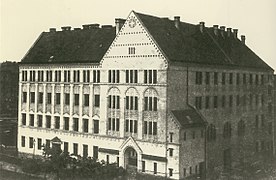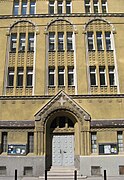Alxingergasse
| Alxingergasse | |
|---|---|
| Street in Vienna | |
| Basic data | |
| place | Vienna |
| District | Favoriten (10th district) |
| Created | 1875 |
| Cross streets | Landgutgasse, Dampfgasse, Hasengasse , Gudrunstraße , Erlachgasse , Pernerstorfergasse , Quellenstraße , Buchengasse , Rotenhofgasse, Davidgasse , Schröttergasse, Inzersdorfer Straße, Angeligasse , Hardtmuthgasse, Troststraße , Dieselgasse |
| Places | Erlachplatz, Laubeplatz |
| Buildings | Parish Church of the Most Holy Trinity |
| use | |
| User groups | Pedestrians , bicycle traffic , car traffic |
| Technical specifications | |
| Street length | approx. 1490 m |
The Alxingergasse is a street in the 10th Vienna district, favorites . It was named in 1875 after the Austrian poet of the Enlightenment period Johann Baptist von Alxinger .
Course and characteristics
Alxingergasse runs in a north-south direction from Landgutgasse up Wienerberg to Dieselgasse. It has 105 house numbers and mostly consists of residential buildings. Many of them date from the end of the 19th century or around 1900. Alxingergasse is a one-way street, touches the green spaces at Erlachplatz and Laubeplatz and is not used by any public transport.
Notable buildings
No. 6: Holy Trinity Church
The parish church of Most Holy Trinity and the adjoining monastery of the Missionary Sisters Servants of St. Geistes was built in 1913/14 according to plans by Richard Jordan . At that time the church was still St. Consecrated to Philomena . It has been a parish church since 1942, the interior was redesigned by Hans Petermair from 1954 to 1959 and consecrated to the Most Holy Trinity in 1962 . The 4-storey facade shows the shapes of a geometrically reduced home style . The interior is a simple, flat-roofed hall. The altar mosaic Holy Trinity from 1959 comes from Ernst Bauernfeind . The church is a listed building .
No. 64: Imperial Fig Coffee Factory
A building of the Imperial fig coffee factory originally stood on the site of today's residential building . This company was founded in 1880 by Adolf Tschepper at Hasengasse 14. The small company was continuously expanded and moved to the Alxingergasse location. In 1908 it was taken over by Karl Kuhlemann and made into the well-known large company.
No. 82: Elementary School
The elementary school was built in 1885 and around 1900 was given another wing to Herzgasse 87.
No. 89–93: Municipal housing
Residential complex of the municipality of Vienna under monument protection . The urban residential complex was built from 1925 to 1926 according to plans by the architect Ernst Egli . It comprises 136 apartments.
No. 96: Residential complex
The residential complex shows two sgraffiti on the facade : Allotment garden life in spring, summer and autumn (1954) by Oswin Amann and Technik (1954) by Hermine Aichenegg .
No. 97–103: Housing complex
In the courtyard of the residential complex there is a natural stone sculpture standing female figure (1960) by Eduard Robitschko .
literature
- Herbert Tschulk: Viennese district culture guide favorites . Jugend & Volk, Vienna 1985, ISBN 3-224-16255-4
- Felix Czeike (Ed.): Alxingergasse. In: Historisches Lexikon Wien . Volume 1, Kremayr & Scheriau, Vienna 1992, ISBN 3-218-00543-4 , p. 79 ( digitized version ).
- Dehio Handbook Vienna. X. to XIX. and XXI. to XXIII. District . Verlag Anton Schroll, Vienna 1996
Web links
Coordinates: 48 ° 10 '23.3 " N , 16 ° 22' 3.4" E







